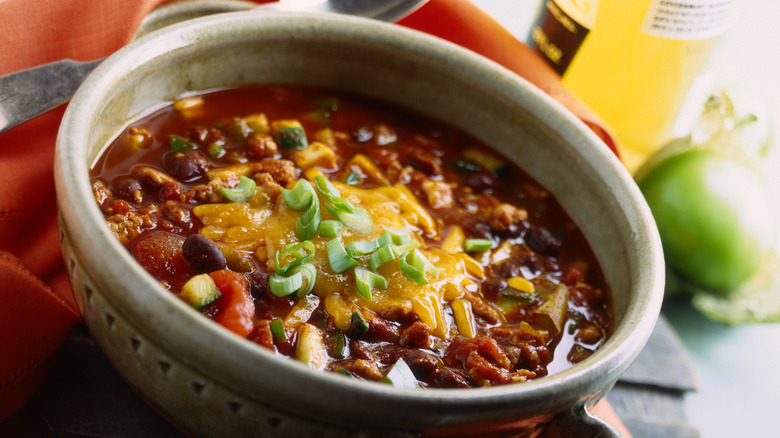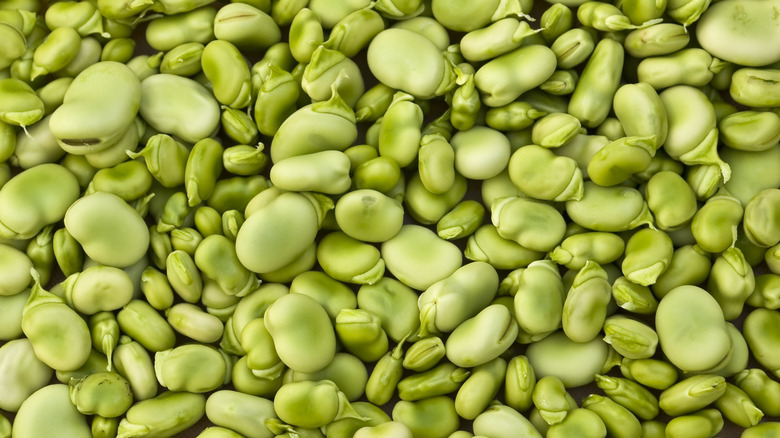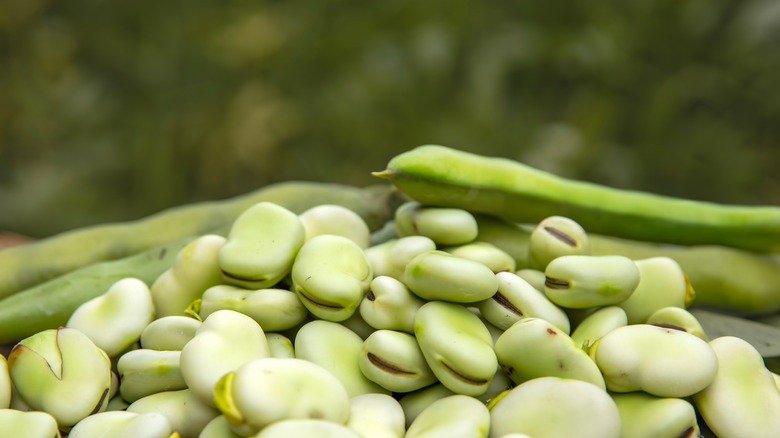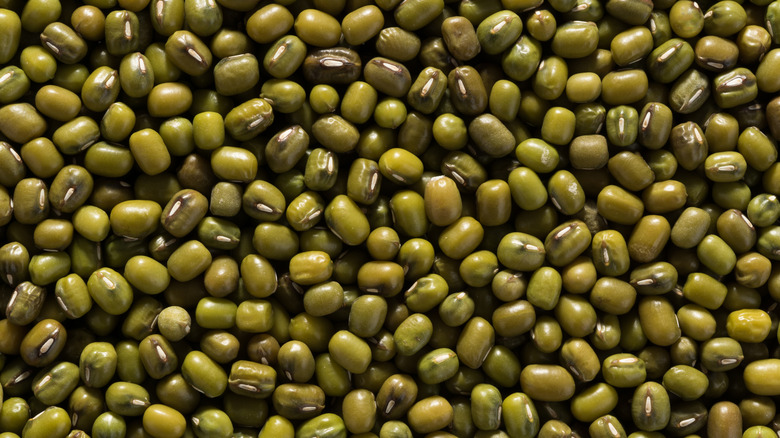The 4 Best And 4 Worst Canned Beans For Chili
I've tested plenty of different canned beans over the years in chili recipes. Whether I'm making a big batch in a kitchen at work or preparing a piping hot pot of it at home, chili is a staple of my diet. I tend to enjoy it best with some shredded cheese and diced onions on top along with some of my favorite store-bought tortilla chips. But part of what I love about chili is how versatile it is. While you can always keep it simple and eat it plain from the bowl, the meaty richness of chili can take everything from macaroni and cheese to crispy quesadillas to the next level. Despite all the pleas from Texans begging me to stop putting beans in my chili, the truth is I'd never dream of making it without these nutritious little legumes. My long history of loyalty and appreciation for the almighty bean runs far too deep to ever leave it behind.
That said, in terms of taste and texture, bean varieties can be drastically different from each other. Some beans have enough fortitude to hold up well simmering in a stew, while others turn to mush. Some beans have a creamy taste and texture that pairs well with the flavors of chili, while others simply don't. Read on to learn more about some of the best and worst canned beans for chili.
Best: Kidney beans
Kidney beans are a wise choice when it comes to a wholesome homemade chili. Kidney beans have enough fortitude to withstand being simmered for a while, which means they can soak up the flavors of chili without devolving into mush. They have a thicker skin that gives them more structural integrity than some other bean types. Kidney beans are also quite large, making the chili significantly heartier, more filling, and satisfying.
Above and beyond mere texture, though, kidney beans have a light, earthy flavor and inner creaminess that pairs well with chili. Biting into tender kidney beans along with chunks of browned beef, diced onions, and juicy tomatoes makes for spoonful after spoonful of deliciousness. Even the dark red color of kidney beans seems perfectly suited for the bubbling crimson broth of chili. All in all, kidney beans are definitely one of the best canned beans that chili could possibly ask for.
Worst: Lima beans
To be clear here, I have nothing against lima beans (also known as butter beans) in other contexts. The question here is whether or not these beans are well-suited for chili, and I firmly believe that the answer for that is absolutely not. Lima beans have a grassy flavor that reminds me of edamame. When I think of lima beans, I also think of succotash, chock-full of corn and tomatoes. As someone who was born and raised in the South, in my mind, lima beans are really meant to be prepared as a refreshing side dish for barbecue — not simmered with heavily-spiced meat.
The other problem here (which is a problem for some of the other beans here too) is that lima beans are also quite delicate. After a short simmer, they are highly likely to dissolve and reduce into squishiness. Ideally, we're looking for beans that provide some subtle texture to our chili without totally breaking down, as lima beans tend to do.
Best: Black beans
Black beans are meaty, with a mild flavor that makes them tasty with everything from cheesy nachos to fluffy yellow rice. Even though black beans are on the smaller side, they still manage to hold up surprisingly well in soups, stews, and chilis. They have a thinner skin that makes them a bit more delicate than kidney beans, but they are still dense enough on the inside to give them some solid structure.
There's a reason that black beans are paired in cuisines around the globe with meat-heavy dishes like beef chili and roasted pork. Black beans complement savory ingredients seamlessly, and even act as a great stand-in for meat, as they do in this fantastic homemade black bean burger recipe. Adding a little bit of the liquified starch contained in canned black beans is also an easy way to thicken up your chili's consistency. When you're making chili, there's no doubt that using canned black beans is a surefire way to add some healthy protein and depth of flavor.
Worst: Garbanzo beans
Garbanzo beans, also known as chickpeas, are actually a wonderful ingredient that I cook with all the time. I definitely enjoy seasoning and roasting them in the oven for a healthy and crispy snack, simmering them in curry, or making a handful of other crave-worthy chickpea recipes. But they just don't belong in chili.
A big part of what holds garbanzos back from working in chili is their texture. Garbanzo beans have a slightly grainy texture that manages to work in a dish like chana masala, which is a vegetarian curry with chickpeas as the main ingredient. Because chili often contains meat, though, such as ground beef or pork with their characteristic meaty texture, garbanzo beans add a level of graininess into the mix that just isn't very appealing. Rather than using them in chili, garbanzo beans are better suited for a creamier context — such as a curry made with coconut milk — to smooth out their inherent grittiness.
Best: Cannellini beans
If you've never had cannellini beans before, they're basically just white kidney beans. Cannellini beans share the same kidney-like shape and also tend to be large and plump. Similar to kidney beans, cannellini beans get fluffy and creamy after a short simmer. With their similar shape and texture, cannellini beans are definitely one of the best beans to add to a batch of chili.
The main difference between kidney beans and cannellini beans comes down to taste. Kidney beans are a little sweeter, while cannellini beans are a bit nuttier. That said, the flavor differences here are very subtle and may even be practically undetectable. Cannellini beans can be used pretty much interchangeably with kidney beans in recipes without much fuss. If you're looking to add some visual appeal to your chili, cannellini beans can easily shine through the darker shades of red that normally dominate the bowl, providing a striking contrast that makes chili look extra appetizing.
Worst: Fava beans
Similar to the other beans that fall into the worst category here, just because fava beans aren't exactly cut out for chili doesn't mean that I'm condemning them altogether. Fava beans certainly have their time and place — like Hannibal Lecter, I'm particularly fond of pairing them with liver and a nice Chianti. Okay, now that I've gotten the obligatory "Silence of the Lambs" reference out of the way here, we can move forward. In all seriousness, I think that fava beans are truly meant to be enjoyed as simply as possible — steamed, tossed with a little olive oil, salt, and lemon juice. Fava beans have a buttery sweetness that's best enjoyed alone or in salads beside other fresh vegetables, rather than submerged in thick and meaty stews like chili.
Fava beans are earthy and a little sweet but also a little bitter. This is another case of how this particular bean's natural flavor just doesn't mesh well in a dish like chili — it somehow manages to clash more than it complements.
Best: Pinto beans
Some people say that pinto beans are a little too delicate for chili. They say that pinto beans aren't strong enough to survive the simmering and eventually crumble and dissolve. While that's certainly a fair (and accurate) observation to make, I think that's mostly a result from cooking them too long. For this reason, canned pinto beans are typically the last thing I'll add to the chili pot, because I only want to simmer them for about 5-10 minutes at the very end.
I love how creamy and smooth pinto beans are. Their texture can be particularly useful in chili recipes that use more lean cuts of meat (like ground sirloin, perhaps), to provide some softer textural contrast. The flavor of pinto beans is mild and lacks the bitterness that some other beans have. Their simple yet delicious flavor manages to considerably enhance chili, and pinto beans are also great to have on hand to make homemade refried beans.
Worst: Mung beans
During my time living in Korea, I ate a lot of mung beans in the form of bindaetteok (빈대떡). To make this dish, ground mung beans are soaked with rice in water until softened, then blended into a thick batter. Green onions, kimchi, and pork are often added to the batter, which is then spooned out into small circles on a hot griddle and cooked like pancakes until they're crispy on both sides. Bindaetteok quickly became one of my favorite Korean foods, partly because it reminds me of a twist on a crunchy hash brown patty. All of this is to say that I absolutely do not hate mung beans — I actually love them. But they have a potato-like starchiness to them that I don't think pairs well with a pot of chili.
That said, would I protest if someone threw some canned mung beans in the chili pot? I don't believe that I would. But I'd most likely end up secretly reminiscing about being back in Korea, eating bindaetteok instead.








